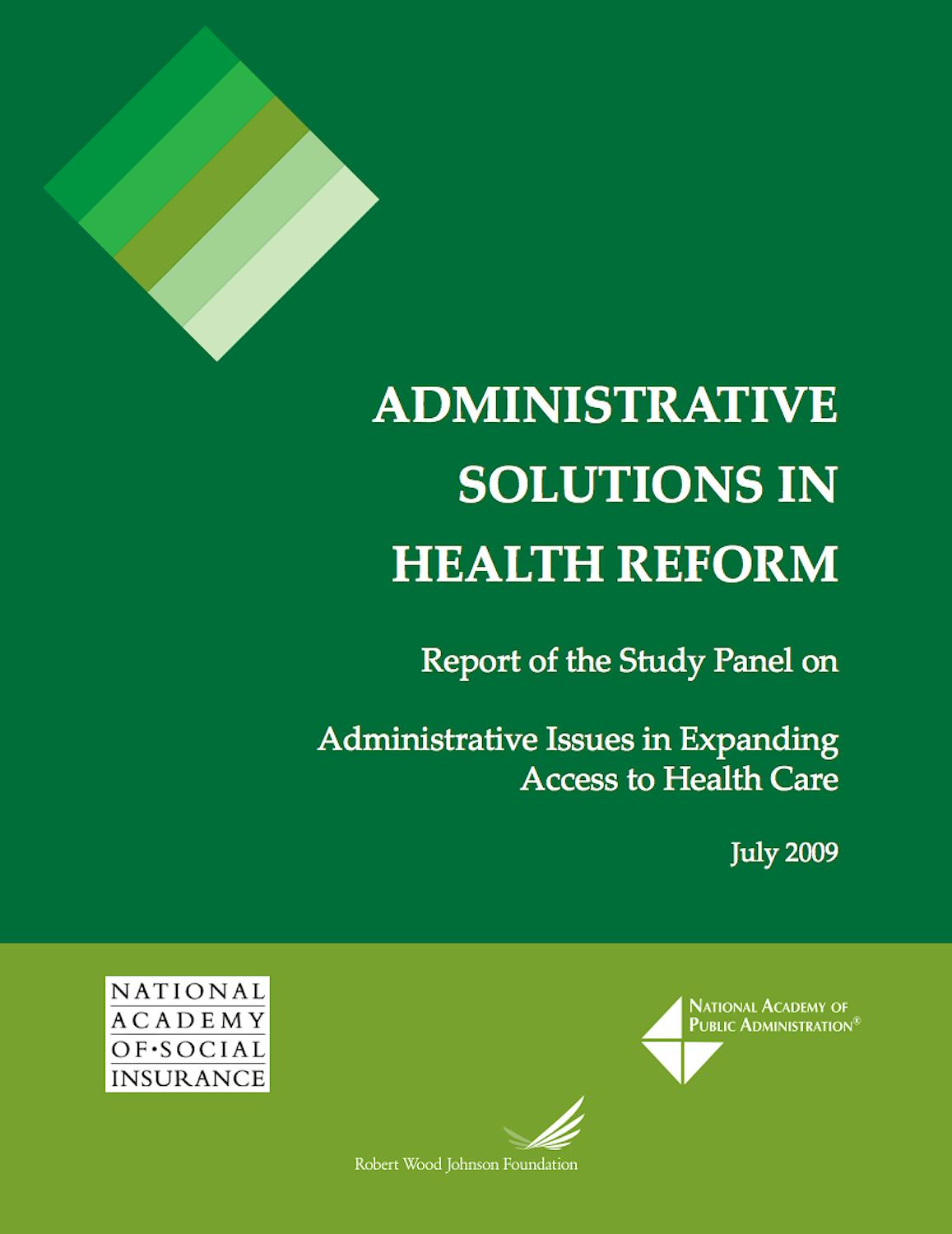
Administrative Solutions in Health Reform: Administrative Issues in Expanding Access to Health Care
The U.S. health care system faces well-known challenges: 46 million people without health insurance coverage in 2007, rapidly rising costs that now consume over 16 percent of the nation’s economic output, and uneven and inequitable quality of care.
The National Academy of Public Administration and the National Academy of Social Insurance partnered with the Robert Wood Johnson Foundation to undertake a sweeping analysis of the management and administrative issues that arise in expanding health coverage. The two-year project identified and described core administrative functions that need to be performed regardless of the health system in place, and assessed how these functions might be performed under different health care alternatives. The panel drew lessons from experiences both in the United States and abroad, and recommended administrative and management approaches designed to facilitate the improvement and expansion of health care coverage.
Click the button below to view the View Study Report.
View ReportKey Findings
All health care delivery and financing structures raise management challenges. This report will help policymakers identify and consider critical management issues as changes to the health care system are designed and implemented. The panel’s most important conclusion was that the administrative challenges posed by expanding access to health care can be met. Experiences with similar programs in the U.S. and abroad, as well as extensive analyses of specific management issues, provide a wealth of guidance for those responsible for designing and implementing reforms. This report and its accompanying volume showed how those experiences and analyses are relevant to the current debate. The panel made no claims about the best policies and programmatic features to adopt in improving and reforming the nation’s health care system. The panel’s objective instead was to set forth the management considerations that they considered important in the design of an effective program.
Recommendations
Planning and Coordinating Implementation
1.1 Administrative issues and their connections with each other should receive careful consideration when developing legislation.
1.2 The agency with primary responsibility for implementing health reform should have political stature and substantial operational flexibility. 1.3 Provide sufficient up-front administrative funds for a successful start.
1.4 Establish an implementation schedule that is ambitious, yet realistic.
Subsidizing Premiums and Cost-Sharing
2.1 Whether health insurance subsidies are administered through the tax system or a spending program, an emphasis should be placed on simplicity.
2.2 Eligibility criteria for subsidies should be easily enforceable and designed not to create incentives for abuse, thus raising either error rates or enforcement budgets.
2.3 Administration can be simplified if subsidies are provided through a health insurance exchange offering insurance plans with comprehensive, standardized benefits.
2.4 The subsidy system should be designed to assure eligibility before making payments and to avoid the need for end-of-year reconciliation or recovery of overpayments.
Administering Health Insurance Mandates
3.1 Emphasis should be placed on encouraging compliance with a mandate rather than penalizing noncompliance.
3.2 Penalties for noncompliance with a mandate should be moderate and collectable.
Regulating Health Insurance
4.1 The federal government should take advantage of the regulatory expertise and administrative mechanisms for protecting consumers that already exist in state governments. One approach would be to develop uniform national standards for health insurance enforced primarily at the state level.
Restructuring Health Insurance Market
5.1 A health insurance exchange could provide a structure for the health insurance market, guarantee individual access to health insurance, promote competition among health insurance plans on the basis of price and quality, and assure that health insurance plans play by the established rules.
5.2 If policymakers create a new public health insurance plan to compete with private plans in an exchange, the public plan should be administered by a separate organizational entity and not by the exchange itself.
5.3 Any restructuring of the health insurance market must account for the unique role of Medicaid in covering low-income and high-risk populations.
Designing Administrative Organizations
6.1 Organizations that use governmental powers and funds and make public policy must be accountable as well as effective.
6.2 Many administrative problems do not have solutions that require new organizational designs.
6.3 The Federal Reserve System does not provide an appropriate model for an entity to manage a national health insurance system.
Simplifying Administration and Controlling Costs
7.1 Efforts should continue to enhance the standardization of health care transactions to reduce administrative costs.
7.2 Investments in comparative effectiveness research and electronic medical records are compatible with a wide range of approaches to expanding health coverage and controlling costs.
7.3 The creation of a health insurance exchange is compatible with all of the major options for controlling health care costs.
